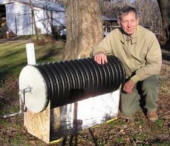
Al Rutan & tabletop digester
The production of natural gas (CH4) occurs everywhere in nature in swamps, bogs, coal mines, land fills and in the guts of warm blooded mammals. In fact, anyplace where organic matter is present and air is excluded.
It is this same vapor gas that the utility companies market. Made by nature and deposited in the ground over eons of time, the chemical formula is one part carbon to four parts hydrogen (CH4). Because the vapor which the utility companies sell is for all practical purposes a non-renewable resource, the price currently is escalating rapidly and will continue to do so. The day of cheap energy in America is over. But there is a way around this dilemma. If we have the material at hand, namely organic waste that is ordinarily manure, we can harness the forces of nature and make our own natural vapor gas at virtually no cost once with the right equipment.
Is this equipment expensive? Not necessarily. All the process requires are three simple conditions: (1) a tank that excludes air, (2) a constant, even temperature of 95 to 100 degrees F, (3) a gentle stirring action. All three of these conditions mimic the conditions that are within the gut of every warm blooded animal, including people: air is excluded, basic metabolism keeps body temperature constant and even throughout the animal, a mixing action occurs by means of the simple movement of food through gut which we call peristalsis.
It is the process of digestion. Some of the food is converted into energy and building material for the cells of the animal including people and some of it passes completely through the alimentary canal. Are we familiar with the definition of the alimentary canal? Webster’s dictionary defines it thus: The tubular passage that extends from mouth to anus and functions in digestion and absorption of food and elimination of residual waste.
It is this same tubular passage that we mimic when we build a tank for producing natural gas, which we call a digester.

4 Responses
That info used to be there. Like I said, he died, and his website went away. The info is now at https://www.green-trust.org/freebooks/
Useless article with no schematics, diagrams or relevant info on how to set up one yourself. A total waste of time, may as well just publish the headline “You can make power” and write nothing else. Generalised crap.
seems his website has no information in it.
He died a few years ago.